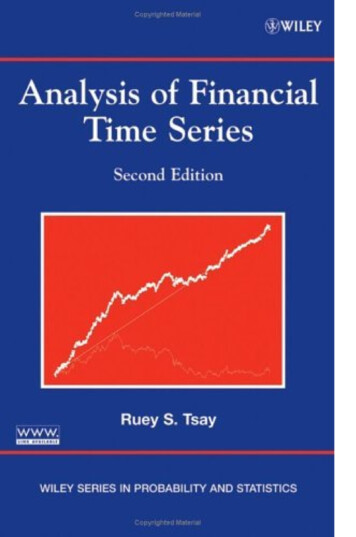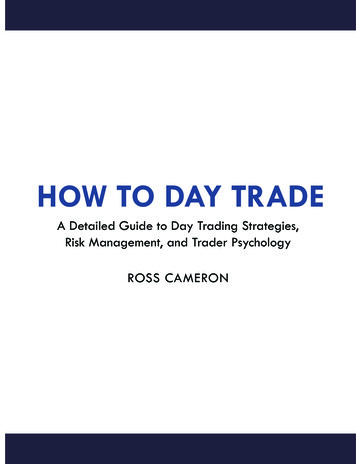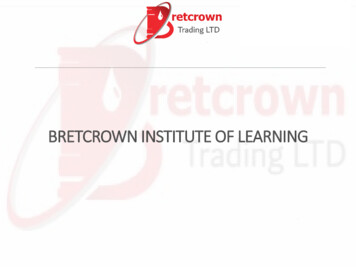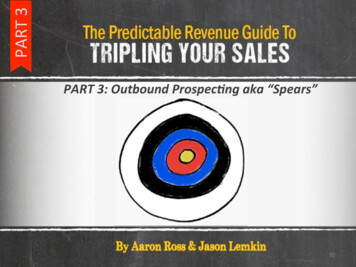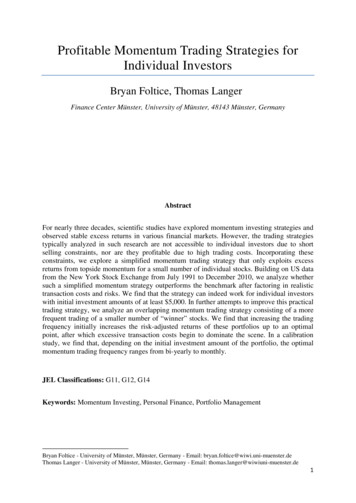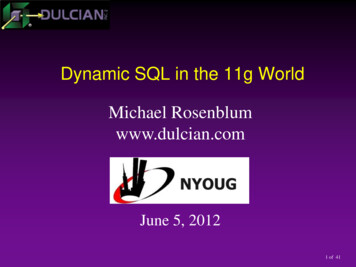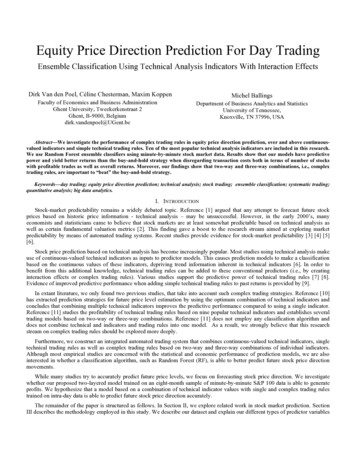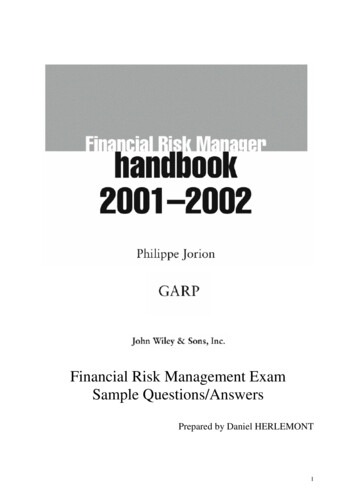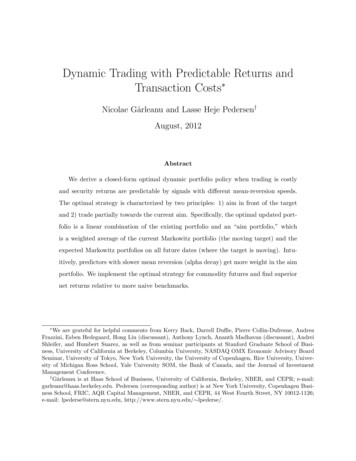
Transcription
Dynamic Trading with Predictable Returns andTransaction Costs Nicolae Gârleanu and Lasse Heje Pedersen†August, 2012AbstractWe derive a closed-form optimal dynamic portfolio policy when trading is costlyand security returns are predictable by signals with different mean-reversion speeds.The optimal strategy is characterized by two principles: 1) aim in front of the targetand 2) trade partially towards the current aim. Specifically, the optimal updated portfolio is a linear combination of the existing portfolio and an “aim portfolio,” whichis a weighted average of the current Markowitz portfolio (the moving target) and theexpected Markowitz portfolios on all future dates (where the target is moving). Intuitively, predictors with slower mean reversion (alpha decay) get more weight in the aimportfolio. We implement the optimal strategy for commodity futures and find superiornet returns relative to more naive benchmarks. We are grateful for helpful comments from Kerry Back, Darrell Duffie, Pierre Collin-Dufresne, AndreaFrazzini, Esben Hedegaard, Hong Liu (discussant), Anthony Lynch, Ananth Madhavan (discussant), AndreiShleifer, and Humbert Suarez, as well as from seminar participants at Stanford Graduate School of Business, University of California at Berkeley, Columbia University, NASDAQ OMX Economic Advisory BoardSeminar, University of Tokyo, New York University, the University of Copenhagen, Rice University, University of Michigan Ross School, Yale University SOM, the Bank of Canada, and the Journal of InvestmentManagement Conference.†Gârleanu is at Haas School of Business, University of California, Berkeley, NBER, and CEPR; e-mail:garleanu@haas.berkeley.edu. Pedersen (corresponding author) is at New York University, Copenhagen Business School, FRIC, AQR Capital Management, NBER, and CEPR, 44 West Fourth Street, NY 10012-1126;e-mail: lpederse@stern.nyu.edu, http://www.stern.nyu.edu/ lpederse/.
Active investors and asset managers — such as hedge funds, mutual funds, and proprietary traders — try to predict security returns and trade to profit from their predictions.Such dynamic trading often entails significant turnover and transaction costs. Hence, anyactive investor must constantly weigh the expected benefit of trading against its costs andrisks. An investor often uses different return predictors, e.g., value and momentum predictors, and these have different prediction strengths and mean-reversion speeds, or, saiddifferently, different “alphas” and “alpha decays.” The alpha decay is important because itdetermines how long time the investor can enjoy high expected returns and, therefore, affectsthe trade-off between returns and transactions costs. For instance, while a momentum signalmay predict that the IBM stock return will be high over the next month, a value signal mightpredict that Cisco will perform well over the next year.This paper addresses how the optimal trading strategy depends on securities’ currentexpected returns, the evolution of expected returns in the future, their risks and correlations,and their transaction costs. We present a closed-form solution for the optimal dynamicportfolio strategy, giving rise to two principles: 1) aim in front of the target and 2) tradepartially towards the current aim.To see the intuition for these portfolio principles, note that the investor would like tokeep his portfolio close to the optimal portfolio in the absence of transaction costs, whichwe call the “Markowitz portfolio” (or the tangency portfolio). The Markowitz portfolio isa moving target since the return-predicting factors change over time. Due to transactioncosts, it is obviously not optimal to trade all the way to the target all the time. Hence,transaction costs make it optimal to slow down the speed of trading and, interestingly, tomodify the aim, not trading directly towards the current Markowitz portfolio. Indeed, theoptimal strategy is to trade towards an “aim portfolio,” which is a weighted average of thecurrent Markowitz portfolio (the moving target) and the expected Markowitz portfolios onall future dates (where the target is moving).While new to finance, these portfolio principles have close analogues in other fields such asthe guidance of missiles towards moving targets, shooting, and sports. For example, related2
dynamic programming principles are used to guide missiles to an enemy airplane in so-called“lead homing” systems. Similarly, hunters are reminded to “lead the duck” when aimingtheir weapon.1 The most famous example from the sports world is perhaps the followingquote from the “great one”:“A great hockey player skates to where the puck is going to be, not where it is.”— Wayne GretzkyAnother way to state our portfolio principle is that the best new portfolio is a combinationof 1) the current portfolio (to reduce turnover), 2) the Markowitz portfolio (to partly getthe best current risk-return trade-off), and 3) the expected optimal portfolio in the future(a dynamic effect).Figure 1 illustrates this natural trading rule. The solid line illustrates the expected pathof the Markowitz portfolio, starting with large positions in both security 1 and security 2,and gradually converging towards its long-term mean (e.g., the market portfolio). The aimportfolio is a weighted-average of the current and future Markowitz portfolios so it lies inthe “convex hull” of the solid line or, equivalently, between the current Markowitz portfolioand the expected aim portfolio next period. The optimal new position is achieved by tradingpartially towards this aim portfolio.In this example, curve in the solid lines means that the Markowitz position in security1 decays more slowly as the predictor that currently “likes” security 1 is more persistent.Therefore, the aim portfolio has a larger position in security 1, and, consequently, the optimaltrade buys more shares in security 1 than it would otherwise. We show that it is in fact a moregeneral principle that predictors with slower mean reversion (alpha decay) get more weightin the aim portfolio. An investor facing transaction costs should trade more aggressively onpersistent signals than on fast mean-reverting signals: the benefits from the former accrueover longer periods, and are therefore larger.The key role played by each return predictor’s mean reversion is an important implicationof our model. It arises because transaction costs imply that the investor cannot easily change1We thank Kerry Back for this analogy.3
his portfolio and, therefore, must consider his optimal portfolio both now and in the future.In contrast, absent transaction costs, the investor can re-optimize at no cost and needs toconsider only the current investment opportunities (and possible hedging demands) withoutregard to alpha decay.Our specification of transaction costs is sufficiently rich to allow for both purely transitoryand persistent costs. Persistent transaction costs means that trading leads to a marketimpact and this effect on prices persists for a while. Indeed, since we focus on market impactcosts, it may be more realistic to consider such persistent effects, especially over short timeperiods. We show that, with persistent transaction costs, the optimal strategy remains totrade partially towards an aim portfolio and to aim in front of the target, though the precisetrading strategy is different and more involved. Furthermore, we offer micro-foundations foreach type of transaction costs, rooted in the inventory costs of liquidity providers who takethe other side of the trades, and illustrate the continuous-time limits (in the appendix).Finally, we illustrate our results empirically in the context of commodity futures markets.We use returns over the past 5 days, 12 months, and 5 years to predict returns. The 5-daysignal is quickly mean reverting (fast alpha decay), the 12-month signal mean reverts moreslowly, whereas the 5-year signal is the most persistent. We calculate the optimal dynamictrading strategy taking transaction costs into account and compare its performance to theoptimal portfolio ignoring transaction costs and to a class of strategies that perform static(one-period) transaction-cost optimization. Our optimal portfolio performs the best net oftransaction costs among all the strategies that we consider. Its net Sharpe ratio is about20% better than that of the best strategy among all the static strategies. Our strategy’ssuperior performance is achieved by trading at an optimal speed and by trading towards aaim portfolio that is optimally tilted towards the more persistent return predictors.We also study the impulse-response of the security positions following a shock to returnpredictors. While the no-transaction-cost position immediately jumps up and mean revertswith the speed of the alpha decay, the optimal position increases more slowly to minimizetrading costs and, depending on the alpha decay speed, may eventually become larger than4
the no-transaction-cost position, as the optimal position is reduced more slowly.The paper is organized as follows. Section 1 describes how our paper contributes tothe portfolio-selection literature that started with Markowitz (1952). We provide a closedform solution for a model with multiple correlated securities and multiple return predictorswith different mean-reversion speeds. The closed-form solution illustrates several intuitiveportfolio principles that are difficult to see in the models following Constantinides (1986),where the solution requires complex numerical techniques even with a single security andno return predictors (i.i.d. returns). Indeed, we uncover the role of alpha decay and theintuitive aim-in-front-of-the-target and trade-towards-the-aim principles, and our empiricalanalysis suggests that these principles are useful.Section 2 lays out the model with temporary transaction costs and lays out the solution method. Section 3 shows the optimality of aiming in front of the target, and tradingpartially towards the aim. Section 4 solves the model with persistent transaction costs.Section 5 provides a number of theoretical applications while Section 6 applies our framework empirically to trading commodity futures. Section 7 concludes. Appendix A containscontinuous-time versions of the temporary and persistent transaction cost models, AppendixB develops micro foundations for these costs, Appendix C shows the connection betweendiscrete and continuous time, Appendix D derives equilibrium implications of the model,showing that transaction costs can help explain high short-term alphas and return reversals.All proofs are in Appendix E.1Related LiteratureA large literature studies portfolio selection with return predictability in the absence of trading costs (see, e.g., Campbell and Viceira (2002) and references therein). Alpha decay playsno role in this literature, and nor does it play a role in the literature on optimal portfolio selection with trading costs but without return predictability following Constantinides(1986).This latter literature models transaction costs as proportional bid-ask spreads and relies5
on numerical solutions. Constantinides (1986) considers a single risky asset in a partial equilibrium and studies trading-cost implications for the equity premium.2 Equilibrium modelswith trading costs include Amihud and Mendelson (1986), Vayanos (1998), Vayanos andVila (1999), Lo, Mamaysky, and Wang (2004), Gârleanu (2009), and Acharya and Pedersen(2005), who also consider time-varying trading costs. Liu (2004) determines the optimaltrading strategy for an investor with constant absolute risk aversion (CARA) and manyindependent securities with both fixed and proportional costs (without predictability). Theassumptions of CARA and independence across securities imply that the optimal positionfor each security is independent of the positions in the other securities.Our trade-partially-towards-the-aim strategy is qualitatively different from the optimalstrategy with proportional or fixed transaction costs, which exhibits periods of no trading.Our strategy mimics a trader who is continuously “floating” limit orders close to the midquote — a strategy that is used in practice. The trading speed (the limit orders’ “fill rate”in our analogy) depends on how large transaction costs the trader is willing to accept (i.e.,on where the limit orders are placed).In a third (and most related) strand of literature, using calibrated numerical solutions,trading costs are combined with incomplete markets by Heaton and Lucas (1996), and withpredictability and time-varying investment opportunity by Balduzzi and Lynch (1999), Lynchand Balduzzi (2000), Jang, Koo, Liu, and Loewenstein (2007), and Lynch and Tan (2008).Grinold (2006) derives the optimal steady-state position with quadratic trading costs and asingle predictor of returns per security. Like Heaton and Lucas (1996) and Grinold (2006),we also rely on quadratic trading costs.A fourth strand of literature derives the optimal trade execution, treating the asset andquantity to trade as given exogenously (see, e.g., Perold (1988), Bertsimas and Lo (1998),Almgren and Chriss (2000), Obizhaeva and Wang (2006), and Engle and Ferstenberg (2007)).2Davis and Norman (1990) provide a more formal analysis of Constantinides’ model. Also, Gârleanu(2009) and Lagos and Rocheteau (2006) show how search frictions and payoff mean-reversion impact howclose one trades to the static portfolio. Our continuous-time model with bounded-variation trading sharesfeatures with Longstaff (2001) and, in the context of predatory trading, by Brunnermeier and Pedersen(2005) and Carlin, Lobo, and Viswanathan (2008). See also Oehmke (2009).6
Finally, quadratic programming techniques are also used in macroeconomics and otherfields, and, usually, the solution comes down to algebraic matrix Riccati equations (see,e.g., Ljungqvist and Sargent (2004) and references therein). We solve our model explicitly,including the Riccati equations.2Model and SolutionWe consider an economy with S securities traded at each time t {0, 1, 2, .}. The securities’price changes between times t and t 1 in excess of the risk-free return, pt 1 (1 rf )pt ,are collected in an S 1 vector rt 1 given byrt 1 Bft ut 1 .(1)Here, ft is a K 1 vector of factors that predict returns,3 B is an S K matrix of factorloadings, and ut 1 is the unpredictable zero-mean noise term with variance vart (ut 1 ) Σ.The return-predicting factor ft is known to the investor already at time t and it evolvesaccording to ft 1 Φft εt 1 ,(2)where ft 1 ft 1 ft is the change in the factors, Φ is a K K matrix of meanreversion coefficients for the factors, and εt 1 is the shock affecting the predictors withvariance vart (εt 1 ) Ω. We impose on Φ standard conditions sufficient to ensure that f isstationary.The interpretation of these assumptions is straightforward: the investor analyzes the securities and his analysis results in forecasts of excess returns. The most direct interpretationis that the investor regresses the return on security s on the factors f that could be pastreturns over various horizons, valuation ratios, and other return-predicting variables, and3The unconditional mean excess returns are also captured in the factors f . E.g., one can let the firstfactor be a constant, ft1 1 for all t, such that the first column of B contains the vector of mean returns.(In this case, the shocks to the first factor are zero, ε1t 0.)7
thus estimates each variable’s ability to predict returns as given by β sk (collected in thematrix B). Alternatively, one can think of each factor as an analyst’s overall assessment ofthe various securities (possibly based on a range of qualitative information) and B as thestrength of these assessments in predicting returns.Trading is costly in this economy and the transaction cost (T C) associated with trading xt xt xt 1 shares is given by1T C( xt ) x Λ xt ,2 t(3)where Λ is a symmetric positive-definite matrix measuring the level of trading costs.4 Trading costs of this form can be thought of as follows. Trading xt shares moves the (average)price by 21 Λ xt , and this results in a total trading cost of xt times the price move, whichgives T C. Hence, Λ (actually, 1/2Λ, for convenience) is a multi-dimensional version of Kyle’slambda, which can also be justified by inventory considerations (e.g., Grossman and Miller(1988) or Greenwood (2005) for the multi-asset case). While this transaction-cost specification is chosen partly for tractability, the empirical literature generally finds transactioncosts to be convex (e.g., Engle, Ferstenberg, and Russell (2008), Lillo, Farmer, and Mantegna (2003)), with some researchers actually estimating quadratic trading costs (e.g., Breen,Hodrick, and Korajczyk (2002)).Most of our results hold with this general transaction cost function, but some of theresulting expressions are simpler in the following special case.Assumption A. Transaction costs are proportional to the amount of risk, Λ λΣ.This assumption means that the transaction cost matrix Λ is some scalar λ 0 times thevariance-covariance matrix of returns, Σ, as is natural and, in fact, implied by the model ofGârleanu, Pedersen, and Poteshman (2008) as well as the micro-foundation that we provide4The assumption that Λ is symmetric is without loss of generality. To see this, suppose that T C( xt ) where Λ̄ is not symmetric. Then, letting Λ be the symmetric part of Λ̄, i.e., Λ (Λ̄ Λ̄ )/2,generates the same trading costs as Λ̄.1 2 xt Λ̄ xt ,8
in Appendix B. To understand this, suppose that a dealer takes the other side of the trade xt , holds this position for a period of time and “lays it off” at the end of the period. Thenthe dealer’s risk is x t Σ xt and the trading cost is the dealer’s compensation for risk,depending on the dealer’s risk aversion reflected by λ.The investor’s objective is to choose the dynamic trading strategy (x0 , x1 , .) to maximizethe present value of all future expected excess returns, penalized for risks and trading costs:"max E0x0 ,x1 ,.X(1 ρ)t 1t # (1 ρ)tγ x x t rt 1 xt Σxt t Λ xt ,22(4)where ρ (0, 1) is a discount factor, and γ is the risk-aversion coefficient.5We solve the model using dynamic programming. We start by introducing a value function V (xt 1 , ft ) measuring the value of entering period t with a portfolio of xt 1 securitiesand observing return-predicting factors ft . The value function solves the Bellman equation: 1 γ V (xt 1 , ft ) max xt Λ xt (1 ρ) xt Et [rt 1 ] xt Σxt Et [V (xt , ft 1 )].xt22(5)The model in its general form can be solved explicitly:Proposition 1 The model has a unique solution and the value function is given by1 1 V (xt , ft 1 ) x t Axx xt xt Axf ft 1 ft 1 Af f ft 1 A0 .22(6)The coefficient matrices Axx , Axf , Af f are stated explicitly in (E.9), (E.12), and (E.15),and Axx is positive definite.65Said differently, the investor has mean-variance preferences over the change in his wealth Wt each timeperiod, net of the risk-free return: Wt 1 rf Wt x t rt 1 T Ct 1 .6Note that Axx and Af f can always be chosen to be symmetric.9
3Results: Aim in Front of the TargetWe next explore the properties of the optimal portfolio policy, which turns out to be intuitiveand relatively simple. The core idea is that the investor aims to achieve a certain position,but trades only partially towards this “aim portfolio” due to transaction costs. The aimportfolio itself combines the current optimal portfolio in the absence of transaction costsand the expected future such portfolios. The formal results are stated in the followingpropositions.Proposition 2 (Trade Partially Towards the Aim) (i) The optimal portfolio isxt xt 1 Λ 1 Axx (aim t xt 1 ) ,(7)which implies trading at a proportional rate given by the the matrix Λ 1 Axx towards the “aimportfolio,”aim t A 1xx Axf ft .(8)(ii) Under Assumption A, the optimal trading rate is the scalar a/λ 1, wherea (γ(1 ρ) λρ) p(γ(1 ρ) λρ)2 4γλ(1 ρ)2.2(1 ρ)(9)The trading rate is decreasing in transaction costs λ and increasing in risk aversion γ.This proposition provides a simple and appealing trading rule. The optimal portfolio isa weighted average of the existing portfolio xt 1 and the aim portfolio:xt aa xt 1 aim t .1 λλ(10)The weight of the aim portfolio — which we also call the “trading rate” — determineshow far the investor should rebalance towards the aim. Interestingly, the optimal portfolioalways rebalances by fixed fraction towards the aim (i.e., the trading rate is independent ofthe current portfolio xt 1 or past portfolios). The optimal trading rate is naturally greater10
if transaction costs are smaller. Said differently, high transaction costs imply that one musttrade more slowly. Also, the trading rate is greater if risk aversion is larger, since a largerrisk aversion makes the risk of deviating from the aim more painful (and a larger absoluterisk aversion can also be viewed as an investor with less capital, for whom transaction costsplay a smaller role).Next, we want to understand the aim portfolio. The aim portfolio in our dynamic settingturns out to be closely related to the optimal portfolio in a static model without transactioncosts (Λ 0), which we call the M arkowitz portfolio. In agreement with the classicalfindings of Markowitz (1952),Markowitz t (γΣ) 1 Bft .(11)Proposition 3 (Aim in Front of the Target) (i) The aim portfolio is the weighted average of the current Markowitz portfolio and the expected future aim portfolio. Under Assumption A, this can be written as follows, letting z γ/(γ a):aim t z Markowitz t (1 z) Et (aim t 1 ).(12)(ii) The aim portfolio can also be expressed as the weighted average of the current Markowitzportfolio and the expected Markowitz portfolios at all future times. Under Assumption A,aim t Xz(1 z)τ t Et (Markowitz τ ) .(13)τ tThe weight z of the current Markowitz portfolio decreases with transaction costs λ and increases in risk aversion γ.We see that the aim portfolio is a weighted average of current and future expectedMarkowitz portfolios. While without transaction costs, the investor would like to hold theMarkowitz portfolio to earn the highest possible risk-adjusted return, with transaction coststhe investor needs to economize on trading and thus trade partially towards the aim and,as a result, he needs to adjust his aim in front of the target. Proposition 3 shows that the11
optimal aim portfolio is an exponential average of current and future Markowitz portfolio,where the weight on the current (and near term) Markowitz portfolio is larger if transactioncosts are smaller.A graphical illustration of optimal trading rule. The optimal trading policy isillustrated in detail in Figure 2. Panel A of Figure 2 shows how the optimal first trade isderived, Panel B how the expected second trade, and Panel C the entire path of expectedfuture trades. Let’s first understand Panel A. The solid curve is the expected path of futureMarkowitz portfolios. Since expected returns mean revert, the expected Markowitz portfolioconverges to its long-term mean, illustrated at the origin of the figure. In this example,asset 2 loads on a factor that decays the fastest, so the future Markowitz positions areexpected to have relatively larger positions in asset 1. As a result of the general alpha decayand transaction costs, the current aim portfolio has smaller positions than the Markowitzportfolio and, as a result of the differential alpha decay, the aim portfolio loads more on inasset 1. The optimal new position is found by moving partially towards the aim portfolio.Panel B shows that the expected next trade is towards the new aim, using the same logicas before. Panel C traces out the entire paths of expected future positions. The optimalstrategy is to chase a moving target, adjusting the aim for alpha decay and trading patientlyby always edging partially towards the aim.7To further understand the aim portfolio, we can characterize the effect of the futureexpected Markowitz portfolios in terms of the different trading signals (or factors), ft , andtheir mean reversion speeds. Indeed, a more persistent factor has a larger effect on futureMarkowitz portfolios than a factors that quickly mean reverts. Indeed, the central relevanceof signal persistence in the presence of transaction costs is one of the distinguishing featuresof our analysis.Proposition 4 (Weight Signals Based on Alpha Decay) (i) Under Assumption A, theaim portfolio is the Markowitz portfolio built as if the signals f were scaled down based onThe parameters underlying these figures are f0 (1, 1) , B I2 2 , φ1 0.1, φ2 0.4, Σ I2 2 ,γ 0.5, ρ 0.05, Λ 2Σ.712
their mean reversion Φ: 1aim t (γΣ) 1aB I Φft .γ(14)(ii) If the matrix Φ is diagonal, Φ diag(φ1 , ., φK ), then the aim portfolio simplifies as theMarkowitz portfolio with each factor ftk scaled down based on its own alpha decay φk : 1aim t (γΣ) B ft1ftK,.,1 φ1 a/γ1 φK a/γ .(15)This proposition shows explicitly the close link between the optimal dynamic aim portfolioin light of transaction costs and the classic Markowitz portfolio. The aim portfolio resemblesthe Markowitz portfolio, but the factors are scaled down based on transaction costs (capturedby a), risk aversion (γ), and, importantly, the mean-reversion speed of the factors (Φ).The aim portfolio is particularly simple under the rather standard assumption that thedynamics of each factor f k depend only on its own level (not the level of the other factors),that is, Φ diag(φ1 , ., φK ) is diagonal, so that Equation (2) simplifies to scalars:k ft 1 φk ftk εkt 1 .(16)The resulting aim portfolio is very similar to the Markowitz portfolio, (γΣ) 1 Bft . Hence,transaction costs imply first that one optimally only trades part of the way towards theaim, and, second, that the aim down-weights each return-predicting factor more the higheris its alpha decay φk . Down-weighting factors reduces the size of the position, and, moreimportantly, changes the relative importance of the different factors. This feature is alsoseen in Figure 2. The convex J-shape of the path of expected future Markowitz portfoliosindicates that the factors that predict a high return for asset 2 decay faster than those thatpredict asset 1. To make this point in a different way, if the expected returns of the twoassets decayed equally fast, then the Markowitz portfolio would be expected to move linearlytowards its long-term mean. Since the aim portfolio downweights the faster decaying factors,the investor trades less towards asset 2. To see this graphically, note that the aim lies below13
the line joining the Markowitz portfolio with the origin, thus downweighting asset 2 relativeto asset 1. Naturally, giving more weight to the more persistent factors means that theinvestor trades towards a portfolio that not only has a high expected return now, but alsois expected to have a high expected return for a longer time in the future.We end this section by considering what portfolio an investor ends up owning if he alwaysfollows our optimal strategy:Proposition 5 (Position Homing In) Suppose that the agent has followed the optimaltrading strategy from time until time t. Then the current portfolio is an exponentiallyweighted average of past aim portfolios. Under Assumption A,xttXa a t τ 1 aim τλλτ (17)We see that the optimal portfolio is an exponentially weighted average of current and pastaim portfolios. Clearly, the history of the past expected returns affects the current positionsince the investor trades patiently to economize on transaction costs. The proposition further implies that the investor can compute the exponentially weighted average of past aimportfolios and always trade all the way to this portfolio (assuming that his initial portfoliostarts at the right place, otherwise the first trade will be suboptimal).4Persistent Transaction CostsIn some cases the impact of trading on prices may have a non-negligible persistent component.If an investor trades weekly and the current prices are unaffected by his trades during theprevious week, then the temporary transaction cost model above is appropriate. However,if the frequency of trading is larger than the resiliency of prices, then the investor will beaffected by persistent price impact costs.To study this situation, we extend the model by letting the price be given by p̄t pt Dtand the investor incur the cost associated with the persistent price distortion Dt in additionto the temporary trading cost T C from before. Hence, the price p̄t is the sum of the price14
pt without the persistent effect of the investor’s own trading (as before) and the new termDt , which captures the accumulated price distortion due to the investor’s (previous) trades.Trading an amount xt pushes prices by C xt such that the price distortion becomesDt C xt , where C is Kyle’s lambda for persistent price moves. Further, the price distortionmean reverts at a speed (or “resiliency”) R. Hence, the price distortion next period (t 1)is:Dt 1 (I R) (Dt C xt ) .(18)The investor’s objective is as before, with a natural modification due to the price distortion:"E0Xt γ f(1 ρ)t 1 x Bf R r(D C x) xΣxttttt2 t # 11 .Λ xt x (1 ρ)t x t 1 C xt xt C xt2 t2(19)Let us explain the various new terms in this objective function. The first term is the positionxt times the expected excess return of the price p̄t pt Dt given inside the inner squarebrackets. As before, the expected excess return of pt is Bft . The expected excess return dueto the post-trade price distortion isDt 1 (1 rf )(Dt C xt ) (R rf ) (Dt C xt ) .(20)The second term is the penalty for taking risk as before. The three terms on the second lineof (19) are discoun
trading strategy taking transaction costs into account and compare its performance to the optimal portfolio ignoring transaction costs and to a class of strategies that perform static (one-period) transaction-cost optimization. Our optimal portfolio performs the best net of transaction costs among all the strategies that we consider.
